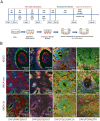Brain organoid model systems of neurodegenerative diseases: recent progress and future prospects
- PMID: 40486729
- PMCID: PMC12141293
- DOI: 10.3389/fnins.2025.1604435
Brain organoid model systems of neurodegenerative diseases: recent progress and future prospects
Abstract
Neurological diseases are a leading cause of disability, morbidity, and mortality, affecting 43% of the world's population. The detailed study of neurological diseases, testing of drugs, and repair of site-specific defects require physiologically relevant models that recapitulate key events and dynamic neurodevelopmental processes in a highly organized fashion. As an evolving technology, self-organizing and self-assembling brain organoids offer the advantage of modeling different stages of brain development in a 3D microenvironment. Herein, we review the utility, advantages, and limitations of the latest breakthroughs in brain organoid endeavors in the context of modeling three of the most prevalent neurodegenerative diseases-Alzheimer's, Parkinson's, and Huntington's disease. We conclude the review with a perspective on the future prospects of brain organoid models with their myriad possible applications in translational medicine.
Keywords: Alzheimer’s disease; Huntington’s disease; Parkinson’s disease; brain; disease modeling; neurodegenerative disorders; organoids; stem cells.
Copyright © 2025 Shaikh, Siddique, Khalifey, Mahereen, Raziq, Firdous, Siddique, Shakir, Ahmed, Akbar, Alshehri, Chinappan, Alzhrani, Mir and Yaqinuddin.
Conflict of interest statement
The authors declare that the research was conducted in the absence of any commercial or financial relationships that could be construed as a potential conflict of interest.
Figures






References
Publication types
LinkOut - more resources
Full Text Sources
Research Materials

